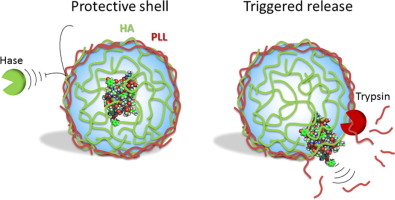Journal of Colloid and Interface Science ( IF 9.9 ) Pub Date : 2018-09-15 , DOI: 10.1016/j.jcis.2018.09.048 Hélène Labie , Adeline Perro , Véronique Lapeyre , Bertrand Goudeau , Bogdan Catargi , Rachel Auzély , Valérie Ravaine

|
A simple route to deliver on demand hydrosoluble molecules such as peptides, packaged in biocompatible and biodegradable microgels, is presented. Hyaluronic acid hydrogel particles with a controlled structure are prepared using a microfluidic approach. Their porosity and their rigidity can be tuned by changing the crosslinking density. These negatively-charged polyelectrolytes interact strongly with positively-charged linear peptides such as poly-l-lysine (PLL). Their interactions induce microgel deswelling and inhibit microgel enzymatic degradability by hyaluronidase. While small PLL penetrate the whole volume of the microgel, PLL larger than the mesh size of the network remain confined at its periphery. They make a complexed layer with reduced pore size, which insulates the microgel inner core from the outer medium. Consequently, enzymatic degradation of the matrix is fully inhibited and non-affinity hydrophilic species can be trapped in the core. Indeed, negatively-charged or small neutral peptides, without interactions with the network, usually diffuse freely across the network. By simple addition of large PLL, they are packaged in the core and can be released on demand, upon introduction of an enzyme that degrades selectively the capping agent. Single polyelectrolyte layer appears as a simple generic method to coat hydrogel-based materials of various scales for encapsulation and controlled delivery of hydrosoluble molecules.
中文翻译:

用带相反电荷的多肽密封透明质酸微凝胶:按需释放包装亲水性药物的简单策略
提出了一种简单的途径,可按需递送包装在生物相容性和可生物降解的微凝胶中的水溶性分子(例如肽)。具有控制结构的透明质酸水凝胶颗粒是使用微流体方法制备的。它们的孔隙率和刚性可以通过改变交联密度来调节。这些带负电的聚电解质与带正电的线性肽(例如聚l-赖氨酸(PLL)。它们的相互作用引起透明质酸酶引起的微凝胶溶胀并抑制微凝胶的酶降解性。当小的PLL穿透微凝胶的整个体积时,大于网络网格大小的PLL仍被限制在其外围。它们形成了孔径减小的复合层,从而使微凝胶内核与外部介质绝缘。因此,基质的酶促降解被完全抑制,并且非亲和性亲水物质可能被困在核心中。实际上,带负电或小的中性肽,而不会与网络相互作用,通常会在网络中自由扩散。通过简单地添加大型PLL,可以将它们封装在内核中,并且可以在引入选择性降解封端剂的酶后按需释放。



























 京公网安备 11010802027423号
京公网安备 11010802027423号